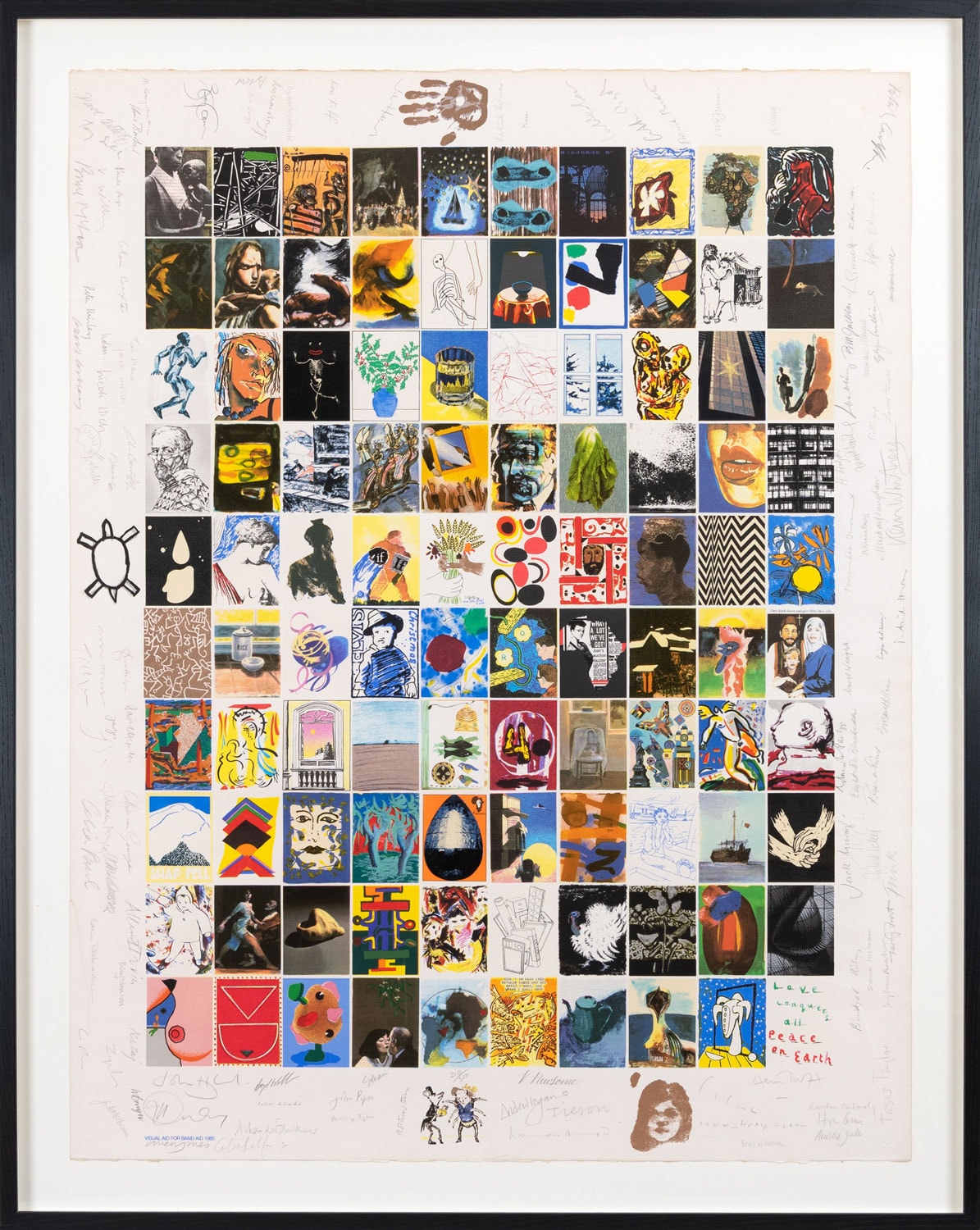The rare Visual Aid charity silkscreen designed by 104 leading British artists
Reading time: 1 min
On the 13th of July 1985, a 16-hour super concert featuring the likes of David Bowie and Queen was broadcasted to a global audience raising over 100 million dollars for Ethiopian countries hit by famine. Though many are familiar with Live Aid, few are aware of the accompanying artwork Visual Aid. We take a look at this limited edition featuring original artworks produced by Bridget Riley, David Hockney and Frank Bowling to name a few.

The widespread famine that affected Ethiopia between 1983 to 1985 was seen as one of the worst humanitarian crises of the twentieth century. Appalled by the disaster – which he viewed to be ‘nowhere on the political agenda’ – singer-songwriter-cum-political activist Bob Geldof decided to raise additional awareness by commissioning 104 artists to create original artworks for a limited edition print. We take a closer look at some of the artist’s interpretations to the tragedy.
David Hockney’s design (which is situated in the bottom right hand corner) stands out amongst a kaleidoscope of shape and colour.
Unlike the majority of his contemporaries who chose to fill their tiles, the influential British artist shrewdly used his space to deliver a simple statement: ‘Love Conquers all Peace on Earth’, using only his signature red and green colour palette.
By leaving the majority of the canvas blank, Hockney draws attention to the peace statement which contrasts with the surrounding, much busier images.
For his interpretation of the brief, Howard Hodgkin (whose design can be found to the above left above Hockney’s) chose to layer hues of orange, yellow and blue against a green background.
Some have suggested the oval brown shape that engulfs the vibrant colours symbolises the widespread famine that destroyed millions of lives.
British illusion artist Patrick Hughes produced a more literal interpretation with an animated skeleton (third row down, third from the left).
It’s been implied that the skeleton, set against a chilling black background, represents the death of over 1 million Ethiopian people. By exaggerating the skeleton’s red lips and white-rimmed eyes similar to the controversial children’s toy, Golliwog, Hughes adds an additional warning not to revert to harmful racial stereotypes.
Other artists produced figurative designs that spoke to the harsh reality of the crisis. Royal Academician Terry Stetch (bottom, third from the right) produced an unsettling interpretation of two figures embracing.
Although Stetch uses cheerful marigold yellow and burnt orange tones, the thick black lines of the emaciated forms serve to reflect the untold hardships of millions of people’s daily plight.
Many artists produced messages of encouragement. English painter and printmaker Patrick Caufield’s screen print features the tip of a white burning candle on a black background, offering a universal symbol of hope.
Collectively, these artworks, which are each accompanied by the respective artist’s signature in the margin, represent an extraordinary piece of political art.
Produced in a run of 500 in 1985 by printmaker and publisher, Coriander Studio, Visual Aid raised £250,000 to aid famine relief across Africa.
Our rare edition of Visual Aid, which is accompanied by a Certificate of Authenticity, also includes a grid of squares featuring the artists names that can be used as a reference for studying the rest of the artworks on the print.
A truly collectible piece, it is archivally mounted and comes presented in a bespoke wooden frame, hand stained with black paint in our Sussex workshop.
Related stories
Subscribe to our newsletter
Be the first to hear about our new collections, limited edition launches, and enjoy artist interviews.
By subscribing you agree to our privacy policy.
Contact us
01273 511 942
View our Christmas hours here
All art prints and images on this website are copyright protected and belong to their respective owners. All rights reserved.




















